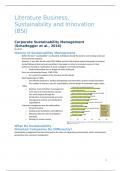Literature Business,
Sustainability and Innovation
(BSI)
Corporate Sustainability Management
(Schaltegger et al., 2016)
Pg. 85-97
History of Sustainability Management
- Before the term “sustainability” was founded, individuals already focussed on overcoming social and
environmental problems.
- However, it was after the oil crises(1970/1980s) and the Club of Rome report that people in business
started following their personal convictions; they began to strive for economic success in their
businesses through a combination of social, ecological, and market principles.
o Profit maximization was no longer the (only) main goal.
- Focus on environmental issues: 1980/1990s
o As a result of accidents in the chemical and oil industry
- Main happenings in 1980s:
o Eco-efficient production, product development and innovation, business model innovation,
the creation of business cases for sustainability, and the design of sustainable supply chains.
- 1990s:
o Business received further encouragement
to be aware of environmental and later
also social impacts through the
introduction of environmental and social
management systems and standards for
organizations
- Corporate management may be motivated by:
o Personal reasons
o Seeking social acceptance and legitimacy
o Reducing risks and costs in production
processes
o Striving for market success
What Do Sustainability-
Oriented Companies Do Differently?
Sustainability management has been informed by the vision of integrating environmental, social, and economic
perspectives into corporate management.
1
,The sustainability triangle is designed to:
1. Explain the three components of corporate sustainability: social, economic and ecological
2. Identify where a contribution is needed from sustainability management.
The corners represent the effectiveness of the company to achieve each component individually and are
measured in absolute terms.
Effectiveness & efficiency
Effectiveness: the goal whenever management strives for the improvement of a single dimension
(e.g., tons of waste avoided, additional income in poor regions)
Efficiency: describes the relationship between different dimensions, e.g., socio-efficiency for the
relationship between the social and economic dimensions
The conventional aim of business management is economic effectiveness.
Challenge: to do this sustainably and to maximize financial returns (profit) relative to financial resources
(capital invested).
A company’s eco-effectiveness (i.e., ecological effectiveness) reflects how successful environmental
management as part of sustainability management has been in reducing its impacts on the natural
environment.
Socio-effectiveness reflects how a company has performed with regard to social and cultural demands
and to legitimate its activities.
Eco-efficiency: the relative proportions of an economic (monetary) measure and a physical (ecological)
measure
Environmental impact added: the sum of all environmental impacts which are generated directly or
indirectly by a product or activity, e.g., value added per tonne of CO2 emitted.
Socio-efficiency: the economic value added relative to social measures, such as the number of staff
accidents.
Eco-justice: the ratio between environmental and social objectives or indicators, e.g., environmental
impacts relative to poverty.
In a way, sustainability management can be considered as the art of overcoming trade-offs between social,
environmental, and economic perspectives and the search for ways to integrate improvements in all
dimensions.
Collaboration as Key to Advance Sustainability
Management
Sustainability management cannot be done successfully by individual actors alone.
2
, It requires interdisciplinary (e.g., environmental experts and engineers working together on a
solution) and transdisciplinary efforts (collaboration within fi rms, between fi rms, and across sectors).
Collaboration Within the Firm: Integrative Approach to
Sustainability
Sustainability management examines production processes and, also, all support functions, such as
planning and control, human resources, financing, and organization.
The need for solutions based on cooperation challenges management with issues of institutionalizing
sustainability management, so that ecological and social objectives become an integral part of all
management areas in all business functions.
Sustainability management only works well if there is support and commitment from top
management, who provides resources to ensure that sustainability management practices are
integrated throughout the organization and in the core business model and processes.
o Also, collaboration is key!!! Not only within an organization, it is also the engagement with
external stakeholders which enables holistic solutions for sustainability.
Collaboration with Value Chain Partners and Other
Societal Actors
Once the company has a clear sustainability strategy, it can leverage results by engaging with partners
along the value chain (suppliers and customers).
In most cases, different actors come together in order to resolve an issue.
Towards Transdisciplinary Collaboration
Sustainability related challenges are often transdisciplinary in nature: not a single sector (industry,
politics), nor a single discipline (environmental sciences) or business function (marketing, production)
can solve them alone.
Conclusions
Sustainability is challenging.
To make sustainability management successful in corporations, collaboration is key, not only within
the organization but, in a transdisciplinary sense, also across organizations, sectors, and disciplines.
What do sustainability leaders do differently from other companies?
o They engage with partners in the value chain such as suppliers and customers, as well as with
other societal actors.
Why?
3
, Sustainability management lowers risks (e.g., protests, bad publicity) and
creates opportunities (e.g., higher prices, lower costs) and thus can create
competitive advantages for sustainability leaders. At the same time, their
actions create value for communities, the environment, and society as a
whole – a notion that has recently been termed “creating shared value”
o Thus: sustainability management attempts to create value for the
company and society alike.
4





